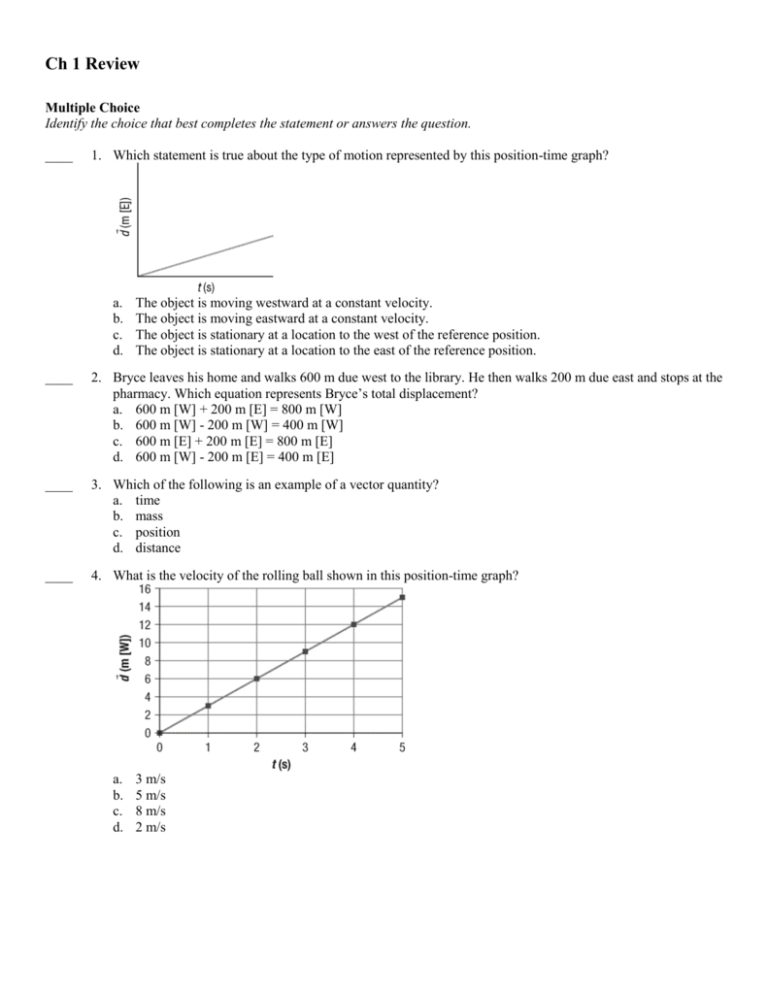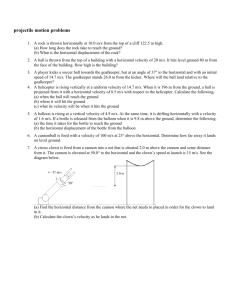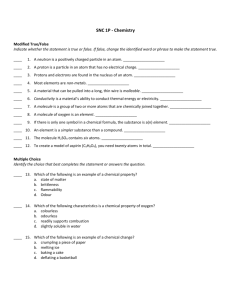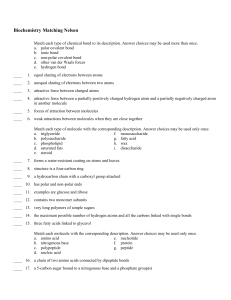File
advertisement

Ch 1 Review Multiple Choice Identify the choice that best completes the statement or answers the question. ____ 1. Which statement is true about the type of motion represented by this position-time graph? a. b. c. d. The object is moving westward at a constant velocity. The object is moving eastward at a constant velocity. The object is stationary at a location to the west of the reference position. The object is stationary at a location to the east of the reference position. ____ 2. Bryce leaves his home and walks 600 m due west to the library. He then walks 200 m due east and stops at the pharmacy. Which equation represents Bryce’s total displacement? a. 600 m [W] + 200 m [E] = 800 m [W] b. 600 m [W] - 200 m [W] = 400 m [W] c. 600 m [E] + 200 m [E] = 800 m [E] d. 600 m [W] - 200 m [E] = 400 m [E] ____ 3. Which of the following is an example of a vector quantity? a. time b. mass c. position d. distance ____ 4. What is the velocity of the rolling ball shown in this position-time graph? a. b. c. d. 3 m/s 5 m/s 8 m/s 2 m/s ____ 5. Which position-time graph represents a stationary object at a location to the west of the reference position? a. b. c. d. ____ 6. Which equation would you use to determine distance travelled if acceleration is uniform and you have been given initial velocity, final velocity, and acceleration? a. b. c. d. ____ ____ 8. An ATV has an average acceleration of 1.9 m/s2. If the vehicle accelerates for 5.8 s and has an initial velocity of 15 m/s [E], what is the final velocity of the ATV? a. 26 m/s [E] b. 21 m/s [E] c. 11 m/s [E] d. 17 m/s [E] 9. A car is passing another car on the highway. It increases its velocity from 12 m/s [E] to 21 m/s [E] over a time interval of 10 s. What is the car’s average acceleration? a. 0.6 m/s2 b. 0.9 m/s2 c. 1.9 m/s2 d. 0.3 m/s2 ____ 7. Which position-time graph represents an object with an increasing velocity moving in a westward direction? a. b. c. d. Modified True/False Indicate whether the statement is true or false. If false, change the identified word or phrase to make the statement true. ____ 1. Displacement means the total length of the path travelled by an object in motion. ____________________ ____ 2. The average velocity of a moving object is the total distance travelled divided by the total time elapsed. ____________________ ____ 3. Accelerated motion is motion in which the object’s speed changes or the object does not travel in a straight line. ____________________ ____ 4. Instantaneous velocity is the velocity of an object when the force due to air resistance equals the force due to gravity on the object. ____________________ Short Answer 1. Create a position–time graph to represent the motion of a cheetah running in a straight line, in an eastward direction, at a constant velocity. 2. What is the average velocity of a baseball that is hit and travels 90.0 m [W] in 2.3 s? Show your work and explain each step. 3. Kristen is trying to determine the average velocity from the following position–time graph and makes the following analysis: “The ball starts at 10.0 m [E] and moves to 50.0 m [E], which is a change of 40.0 m [E]. The time goes from 0 to 12 s, so the average velocity should be m/s [E].” Is Kristen’s analysis correct? If so, explain. If not, identify and correct her mistake. Ch 1 Review Answer Section MULTIPLE CHOICE 1. ANS: LOC: 2. ANS: OBJ: MSC: 3. ANS: OBJ: MSC: 4. ANS: LOC: 5. ANS: LOC: 6. ANS: OBJ: LOC: 7. ANS: LOC: 8. ANS: LOC: 9. ANS: LOC: B PTS: 1 REF: C OBJ: B2.2 MSC: Understanding B PTS: 1 REF: T/I 1.1 Distance, Position, and Displacement LOC: Analysis and Application C PTS: 1 REF: A 1.1 Distance, Position, and Displacement LOC: Understanding A PTS: 1 REF: T/I OBJ: B2.2 MSC: Analysis and Application A PTS: 1 REF: C OBJ: B2.2 MSC: Understanding A PTS: 1 REF: T/I 1.5 Five Key Equations for Motion with Uniform Acceleration B2.3 MSC: Understanding D PTS: 1 REF: C OBJ: B2.2 MSC: Understanding A PTS: 1 REF: T/I OBJ: B2.7 MSC: Analysis and Application B PTS: 1 REF: T/I OBJ: B2.7 MSC: Analysis and Application 1.2 Speed and Velocity B2.5 B3.2 1.2 Speed and Velocity 1.2 Speed and Velocity 1.3 Acceleration 1.3 Acceleration 1.3 Acceleration MODIFIED TRUE/FALSE 1. ANS: F, Distance PTS: 1 LOC: B3.2 2. ANS: F, speed PTS: LOC: 3. ANS: OBJ: 4. ANS: REF: K/U MSC: Knowledge OBJ: 1.1 Distance, Position, and Displacement 1 REF: K/U B3.1 MSC: Knowledge T 1.2 Speed and Velocity F, Terminal OBJ: 1.1 Distance, Position, and Displacement PTS: 1 LOC: B2.1 REF: K/U MSC: Knowledge PTS: 1 LOC: B2.1 REF: K/U MSC: Knowledge OBJ: 1.6 Acceleration Near Earth's Surface SHORT ANSWER 1. ANS: PTS: 1 REF: C OBJ: 1.2 Speed and Velocity LOC: B2.2 MSC: Analysis and Application 2. ANS: Given: = 90.0 m [W]; = 2.3 s Required: Analysis: Solution: Statement: The average velocity of the baseball is 39 m/s [W]. PTS: 1 REF: T/I OBJ: 1.2 Speed and Velocity LOC: B2.7 MSC: Analysis and Application 3. ANS: No, Kristen’s analysis is not correct. She did not calculate the slope correctly. She calculated the change in position and change in time correctly, but then used run over rise instead of rise over run. The correct answer should be PTS: 1 LOC: B3.2 REF: C MSC: Evaluation OBJ: 1.2 Speed and Velocity











